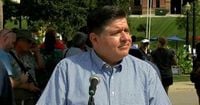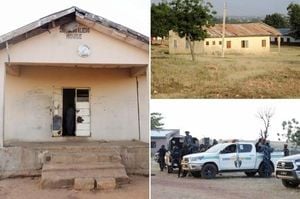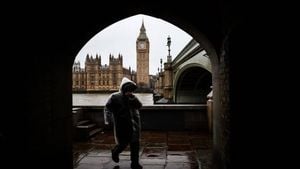In the swirling world of American politics, the 2028 presidential race is already casting a long shadow—despite admonitions from within the Democratic Party to focus on the here and now. Maryland Governor Wes Moore, one of the party’s rising stars, recently made headlines when he cautioned Democrats against eyeing the next presidential cycle so soon. On a podcast aired August 13, 2025, Moore didn’t mince words, declaring that even considering 2028 is “disqualifying.” It was a call for discipline, urgency, and present-mindedness, but it landed in a moment when the party is grappling with a crisis of identity and a growing hunger for fresh leadership.
According to The Wall Street Journal, Democratic favorability has plummeted to a 35-year low. The party, once branded as the engine of progress and change, is now seen by many as the party of the status quo. Voters under 40, especially, seem disengaged—when asked what Democrats stand for, too many simply shrug. Swing voters in battleground states, too, are increasingly skeptical about the party’s direction, and the numbers reflect that malaise. The perception war is being lost, and the need for a course correction feels urgent.
Yet, for all its current woes, the Democratic bench is deep and, by many accounts, exceptional. The list of potential standard bearers reads like a who’s who of contemporary American politics: governors Wes Moore, Gretchen Whitmer, Andy Beshear, Josh Shapiro, JB Pritzker, Gavin Newsom, and Phil Murphy are all widely viewed as effective leaders with broad appeal. There are also senators like Ruben Gallego, Elissa Slotkin, Chris Coons, and Chris Murphy; mayors such as Mitch Landrieu and Justin Bibb; cabinet secretaries Gina Raimondo and Pete Buttigieg; and rising congressional voices like James Talarico and Sarah McBride. Looking ahead to 2025, congressional representatives Mikie Sherrill in New Jersey and Abigail Spanberger in Virginia are set to run for governor, adding further depth to the party’s leadership pool.
Organizations like NewDEAL Leaders and Next50 are working to recruit, elect, and support the next generation of state and local Democratic leaders. It’s not for lack of talent that the party finds itself in a branding rut—it’s a visibility problem. As one party strategist put it, “Voters don’t fall in love with résumés—or even results. They connect with people who show up, speak clearly, and make them feel seen.” The challenge, then, is to get these leaders out from the shadows and into the national spotlight, so voters can connect with new faces and fresh ideas.
This is where the 2028 conversation gets complicated. Governor Moore’s warning about premature presidential jockeying is rooted in a desire to keep the party unified and focused on the pressing work of 2025 and 2026: winning gubernatorial races, flipping red seats, and rebuilding the party’s image. But there’s a counterargument gaining traction, especially among those who believe the party’s malaise is partly due to its reluctance to showcase new leadership early and often. “You don’t change the brand with a message—you change it with leaders,” one Democratic operative observed, echoing a growing sentiment that waiting until after the midterms to elevate new talent is a tradition that may be doing more harm than good.
Meanwhile, a surprising new name has entered the conversation—one that’s both outside the traditional political establishment and, paradoxically, deeply familiar to millions of Americans: Jon Stewart. The comedian and longtime host of ‘The Daily Show’ has, over the years, become a trusted voice on politics and culture. On August 12, 2025, Stewart hosted journalist Mehdi Hasan on his podcast, ‘The Weekly Show with Jon Stewart.’ During their conversation, Stewart mused aloud about whether the Democratic Party was “ripe for a takeover” and joked about the need for the “right reality host” to step in. When Hasan pressed Stewart on whether he was hinting at his own presidential ambitions, Stewart didn’t deny the possibility. Instead, he simply laughed and leaned back—neither confirming nor ruling out a run.
This ambiguity has only fueled speculation. According to Hasan, “The clamor for a Jon Stewart presidential candidacy is growing.” Progressive YouTuber Kyle Kulinski tweeted “JON STEWART 2028” just two days after Democrats lost to Donald Trump for a second time. Radio host Charlamagne tha God voiced his support on Fox, describing Stewart as “a change agent coming from the outside that’s really going to shake things up and somebody that I feel like can speak to all people.” Charlamagne noted that Stewart isn’t just a celebrity—he’s someone who “has gotten legislation and stuff passed before. We know where his heart is.”
What’s more, Democratic voters appear open to the idea. A poll conducted in April 2025 showed Stewart tied with prominent Democratic governors Gretchen Whitmer, JB Pritzker, and Josh Shapiro, and ahead of Andy Beshear, in terms of potential support for a 2028 presidential bid. Imagine, some pundits say, what those numbers might look like if Stewart were to formally declare—if he launched an exploratory committee, for instance, or made an earnest pitch to Democratic primary voters.
Hasan, for his part, admits his own skepticism is waning. He once cautioned against the idea of a Stewart candidacy, preferring the comedian stay in his lane as an educator and entertainer. But now, he’s warming up to the possibility, even suggesting Stewart could shake up the Democratic primaries or challenge incumbent politicians like Cory Booker in New Jersey. Stewart’s unique blend of wit, policy knowledge, and outsider status, Hasan argues, may be just what the party needs to reinvigorate itself and reconnect with disaffected voters.
Still, the prospect of a Stewart candidacy raises thorny questions. Is the Democratic Party truly ready for a celebrity outsider, even one with a track record of advocacy and legislative impact? Would Stewart’s comedic background be an asset or a liability in a bruising national campaign? And how would his entry into the race affect the deep bench of experienced Democratic leaders already jockeying for position?
For now, the party faces a delicate balancing act. On one hand, there’s Governor Moore’s call for focus and unity—a plea to keep eyes on the immediate battles and avoid distractions. On the other, there’s a growing chorus urging the party to embrace new faces and bold voices, to start the work of rebuilding its brand and broadening its appeal without delay. As one strategist put it, “Anyone eyeing 2028 should be doing that work now—or step aside for someone who will.” That means showing up for down-ballot candidates, organizing with state parties, raising money, recruiting talent, and taking a stand on the issues that matter most to voters.
Whether the Democratic Party’s next leader emerges from the ranks of seasoned governors, rising mayors, or even the world of late-night comedy remains to be seen. But one thing is clear: the stakes have rarely felt higher, and the appetite for change—both within the party and among the electorate—is palpable.
As the 2028 cycle looms ever closer, Democrats face a pivotal choice: double down on experience and tradition, or take a risk on a new kind of leader. The answer may well determine not just the party’s fortunes, but the direction of American politics for years to come.





